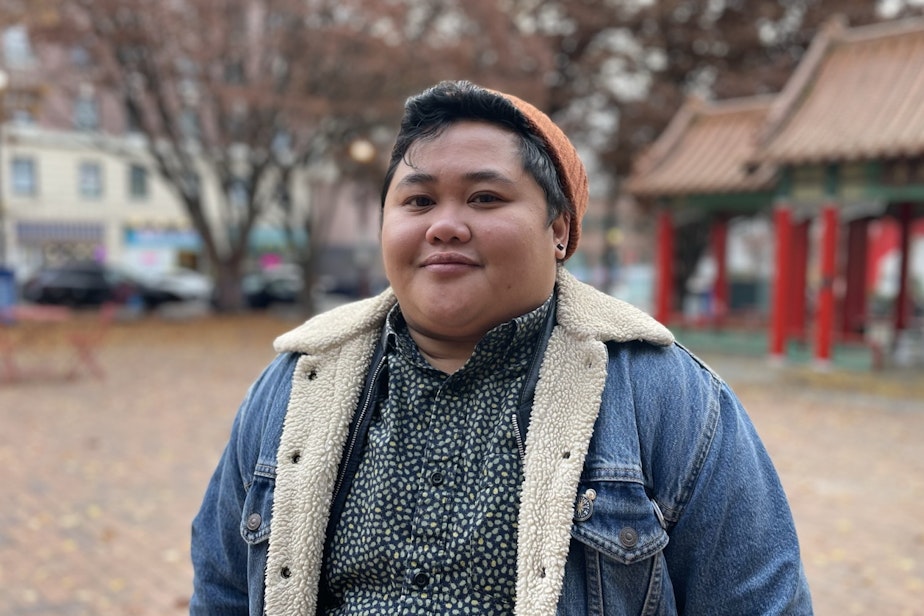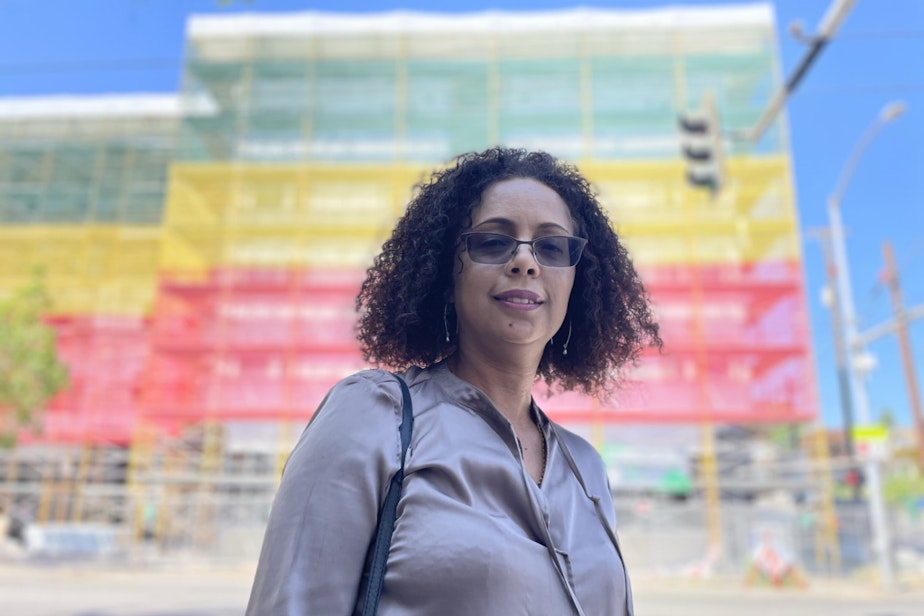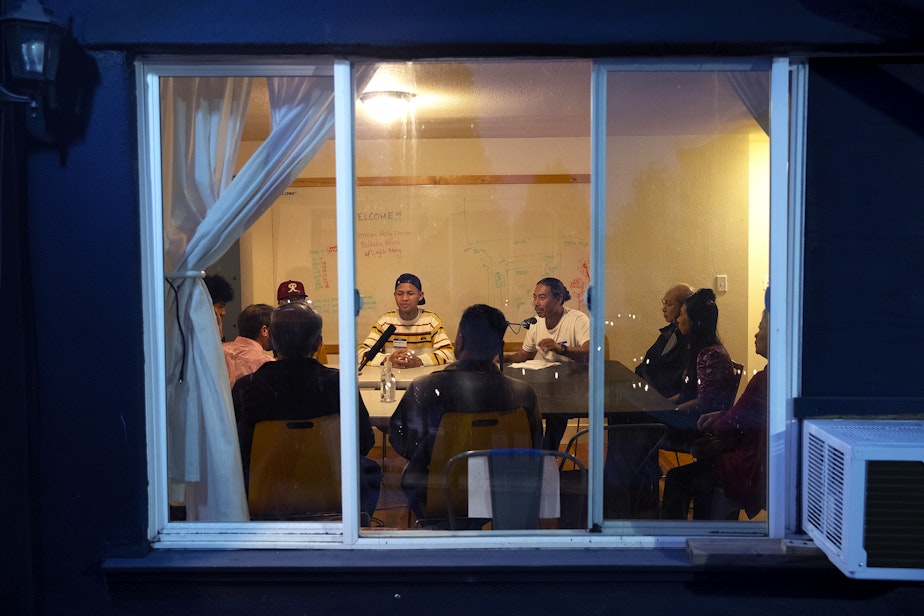How to create community out of a bunch of buildings: The Ripple Effect

It takes more than good planning to create a community that’s there for you when plans fall short.
This is Part 4 of KUOW's series "The Ripple Effect," in which we cover how growth is pushing people away from the Seattle area and potential solutions to the problem.
In Part 1, we explored how displacement pressure feels in one specific community. In Part 2, we chased ripples of displacement across the region. In Part 3, we took a road trip to see solutions in action. In this final segment, we explore the missing element of community, and how to bring it to the new places we'll build.
This four-part series first aired as a special episode of KUOW's Soundside. You can click the "play" button to hear the whole one-hour documentary, or you can read the story in four abridged web stories here.
Y
ou can design a neighborhood that looks perfect on paper: diverse, with mixed incomes and a variety of home sizes for everyone. But it’s still just a bunch of buildings and open space. It’s not a community — yet.
People who've been displaced to an area — and people who've faced displacement pressure there — conceive of their community in different ways. So how do we give the new places we're building, where such different people can live together, a sense of community?
Sponsored
To start looking for answers, I went to a winter farmers market in Tacoma’s Proctor neighborhood. It was cold and rainy, but people showed up anyway, to buy veggies and line up for hot samosas and bagels. And I started asking people: what makes a community?
Alex Koh told me it’s food — you’re never short on conversation when there’s great food around.
Florence Tanaka said it’s having a place to run into friends, so you can catch up on news about their kids and dogs.
Diverse new people to meet, said Cheri Lewis, who has fallen in love with Hmong culture since befriending several flower sellers there.
A lack of cars threatening to run you over, said Scott Foster.
Sponsored
“We need to remember that we're here for each other. But we forget that,” said Chef Mason, who comes to the market every week to sell cheesecake.
A place to live and a place to gather
For his answer, Ted Walkley pointed to the new apartment buildings surrounding the busy farmers market. They were very controversial early on, he said.
“But look what they did. Look at all the people.”
He said he and his wife hope to one day downsize into one of those buildings. It offers an affordable and more attractive alternative to moving into a retirement home somewhere, he said.
Sponsored
“You can have a bunch of people living who just live separately. You could live in an apartment building and not know your neighbors for 20 years. You could live next door to someone and not know them. But you could live in a place like this, where you meet people, you talk to people, and I think it’s contagious,” he said, the spirit of sharing spilling out into neighborhoods around it.
So those are some ideas. A lot of them come down to relationships, which Walkley says begin in a physical place like a farmers’ market.
And Ken Workman, of the Duwamish, said that’s important.
“We’re defined by the place. For example, the Duwamish, ‘Du’ means inside, so ‘inside people.’ Suquamish. ‘Su:’ ‘clear water people.’ So we’re defined by these regions. Hah-choo-AHBSH. Hah-choo is lake Washington, and ‘ahbsh’ are people. So, ‘People of Lake Washington.’”

Sponsored
First steps to build trust
I wanted to understand how to build community — in places that’ve been scarred by displacement.
The key to working across differences, for Workman, is to learn something about the person you’ll be talking to: “Who are they? Where do they come from? What are their fears?”
Then, he uses this knowledge to set the proper tone.
"And so, often when I speak, I say the word 'thank you,'" Workman said. "But if I'm speaking to a Native person from Alaska, a Tlinget person who comes from southern Alaska, then I would say ‘gunalchéesh.’ And this is their word for 'thank you.'
Sponsored
Workman has learned more than a dozen ways to say “thank you": Hy'shqe (Lummi); Tigʷicid (Tulalip); S’quideed (Duwamish – phonetic transcription); K’aiko (Makah – phonetic transcription).
“But you have to say it twice,” workman corrected me, “'K’aiko k’aiko,' like that with that popping sound. So they will know that I hear them and that I am not only recognizing them as a person, giving the substance, but I’m also attempting to learn their language. And they’re appreciative of that.”
Give young people reasons to stay in communities
I was sharing some of those thoughts with Nancy Salguero McKay, director of the Highline Heritage Museum. I mentioned Cunningham Thach, a young man who learned so much about his heritage from friends and mentors he met in South Park, but questioned his future there as those same people were priced out.
Salguero said she had something to show me in the back room: an art project made by kids. On each sheet of paper, a child had outlined one of their hands, and had written down some personal thoughts about their identity – and how they fit into their community.

“This is kids talking about their own heritage," Salguero said. "And how, even with kids, they can already feel frustrated. They can already feel they are not wanted, like they do not want to stay in the area.
"I mean, I’m actually shaking a little bit" she added, because if people feel part of a community that supports them, it can make all the difference in their lives.
“If you don’t have that, why? If you don’t have...somebody who’s basically poking at you, saying, 'Inject energy, inject passion, inject inspiration,' you’re just mechanically going through things and then just surviving. I know about survival mode.
"I know what it is to sleep on the ground, I know what it is to be an immigrant without voice. I used hearing aids for the first eight years of my life; I was unable to speak because I’m 80% deaf. So I know what it is to not to speak, and the importance and significance of even being able to have a dialogue just to say, 'Yes, I see you, yes, you matter, and yes, you have the right to express your frustrations, your anger, your sadness.'"
Translate deep listening into built environments
I also found a group called Puget Sound Sage, that’s trying help people use their voice to build up communities.
“Displacement as a human condition – it puts people in constant distress and constant survival mode. And it’s hard to dream and imagine,” said Ab Juaner, the group’s program manager for equitable development.

Juaner said people know what their communities need. What they lack are resources. Puget Sound Sage tries to bring those together.
“We’re looking to really figure out what it would take for communities to control development in their neighborhoods.”
In practice, that means helping groups of people at risk of displacement purchase land, and then letting them democratically decide what to build on that land.
“Because we want to see them imagine themselves living and working and thriving in place, and it needs to start now,” Juaner said.
A real life example: Ethiopian Village
This may sound like a pie-in-the-sky idea. But in Seattle, you can already find several projects built under a program like that, including a 90-unit senior housing project in Rainier Beach that primarily serves Ethiopian elders.

Sophia Benalfew, director of the group Ethiopian Communities of Seattle, described the process to me.
“A number of community members got together and talked about increasing prices — rent prices — here in the community," she said. "And especially the challenges that seniors are facing to afford that. So with that came the idea of, you know, why don’t we build a building to help the seniors who are struggling to stay in Seattle."
RELATED: Displacement is a big problem in Seattle. Subsidized apartments help, but only somewhat
Benalfew said that project is almost done.
And now, King County has just adopted its own Equitable Development Initiative program.
Recognizing your power and giving some of it up is key
Throughout KUOW's "The Ripple Effect" series, we’ve been trying to answer this question: how can we grow as a region, without pushing people out?
We’ve heard about a lot of solutions. But the solutions themselves have raised a several questions: what is a complete community? what is a resilient community?
“I guess being able to stay is what a resilient community is. Is what a complete community is,” answered Bunthay Cheam, the freelance reporter I’ve been talking to throughout this project.
Bunthay and I sat down together, listened through all the interviews you’ve heard or read in this series.
And then we talked about the cycle of displacement, and how we might break that cycle.
Bunthay brought up a former Wallingford resident, who moved to South Park after being priced out of his previous neighborhood, who we met in Part 2 of "The Ripple Effect."
“You know, despite the fact that they feel like they can't afford to live in Wallingford, they have the privilege and the economic space to move around while the folks...that had been always been there don't...have the power necessarily, to stay if somebody pushed them hard enough. And they leave because they don't have that power,” Bunthay said.
“I always look at the folks that have more power, right? What can they do? How can they give up more of their power?"

“I don't know if this is true,” he added, turning to me, “but let's assume that your great grandparents had land since 18-something and that wealth is being passed down the line. And then one day, you're like, ‘Oh, you know what? I'm privileged because my grandparents were homesteaders and they got all this land.’ And what would that look like to say, ‘Hey, I understand that in this institution, my ancestors have benefited heavily, especially in the last century.’
“’So what does it look like if I moved into the Central District?’ What does that look like to give to the community that has been displaced out there? Right? What does it mean to participate in programs or whatever, to give back to communities? And in that way, you become part of that community. Right? Because you're giving a piece of yourself.”
He added, “I think, if you go into any community, the folks that have just gotten there, it's probably really hard for them. Right? Because you felt like you worked hard for that. And so who's willing to do that?”

Bunthay then mentioned Ken Workman’s strategy of learning how to say "thank you" in the native languages of people he was speaking with. Then he turned to the larger question that raises: "what are ways we can decenter ourselves, for the folks in power to decenter themselves, and really have intentional ways of connecting with these different communities that, by all accounts, by all this data, say they are the people that are impacted the most? How do you truly reach them? "
“I always think about that, even for myself, or if I'm walking into a community: how do I get outside of myself? And get outside of what I know.”
“So how do I say ‘thank you’ in Khmer?” I asked.
“Au kun.”
“Well, Bunthay, au kun for joining me and talking about this,” I said.
“Au kun to you, and I really appreciate the opportunity,” he said. “Yeah, it was really a really, really dope experience.”
The following "Reporter's Notebooks" give two different inside views of this project:
- Reporter's notebook: Centering underrepresented communities in the stories we tell
- Reporter's notebook: How the Ripple Effect series came to be.
This story is part of KUOW's series, The Ripple Effect: How Seattle's housing woes push people out and what to do about it.
- The series was reported and written by Joshua McNichols, KUOW’s Growth and Development reporter.
- Freelance reporter Bunthay Cheam contributed to this report.
- Producers Sarah Leibovitz and Jason Burrows helped mix the audio documentary.
- Kamna Shaastri helped with community engagement.





